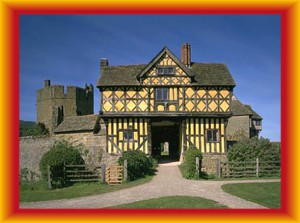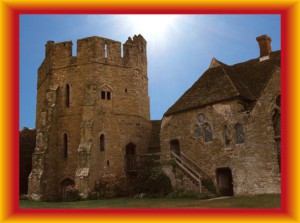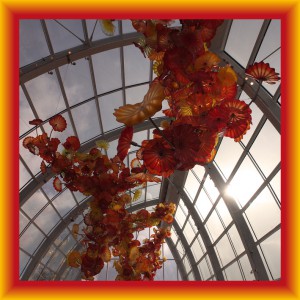Stokesay is reached through one of the arches of the Helgram Central Nexus colonnade, accessed by pressing the right column in just the right place. As you pass through, you step through onto a finely kept lawn, cut every so often with paths and neatly striped by mowing. Behind you is a small formal garden, which then ends in a high hedge. In front of you is the gateway into a fortified manor house, done in the half-timbered style. A stone tower can be seen behind it. The overall feeling is of medieval England.

The half-timbered gatehouse arch is about 15ft feet wide, and guarded by soldiers in Helgram livery. As you reach it, you can see the castle ward in front of you, which is roughly 120ft by 80ft in size. Much of it is surrounded by a single curtain wall, about six feet wide, with wooden buildings built onto the side: a barracks on the south wall, and stables and workshops on the north. However, there is a range of stone buildings directly opposite the gatehouse.
The leftmost (south) building of the range is a four-storey, stone tower-house style keep, which is entered through a separate barbican and topped with six-foot high crenulations.
This tower is linked at ground level by a two-storey closed walkway to a large stone hall. The only obvious external entrance to the hall is reached by a wooden stairway to the first floor. Joined onto that building to the right is a smaller tower of roughly the same height, which is topped with another half-timbered structure, and is again only entered at the first floor level.
Helgram liveried guards can be seen around the castle ward: part of the small onsite garrison of around fifty. There are also a dozen servants, including the Major Domo, cooks and general maids and footmen, and probably another dozen craftsmen like carpenters, armourers, falconers etc.
The Castle
South Tower

The South Tower stands four storeys high, and is entered through a sturdy gatehouse/barbican, complete with portcullis and murder holes. The ground floor is a guard room, protecting both the keep and the entrance to the walkway across to the main building. The walkway has separate portcullis, which can be dropped if required. The walkway structure is 20ft wide, but within it, a single-width stone partition wall has been built, splitting it into a 7ft walkway, on the external side; and a range of rooms on the internal, comprising modern bathroom facilities, barracks rooms and a comfortable lounge and kitchen area.
There is a single chimney running up the south wall of the tower. There is also a well shaft for emergencies, and a small but functional toilet facility built into the inner wall. A single spiral staircase leads up to the first floor, which comprises a larder and small kitchen with a modern tea point, and an open fire. Additional granaries and storerooms, plus an armoury, are located in the upper storey of the walkway, which can also be blocked off via portcullis.
The floor above that is a single, open plan room carpeted with rushes, which can be used for emergency accommodations. A single staircase in the wall leads up onto the roof, where there is a structure which looks something like a pillbox, with an anti-aircraft gun on the top. This has two entrances: one into the gun chamber, and a second connects straight to the Helgram Citadel, in case of emergencies. If all else fails, the Tower is designed to be self-sufficient if needed.
The views from the roof are stunning.
To the east, beyond the hedged lawn through which you arrive, is grazing land, and assorted animals can be seen dotted in fields. Villages and farms can be seen in the distance.
To the south, is cultivated farmland, with rich red earth and a variety of crops. What isn’t immediately obvious, however, is how you reach any of them, as the only entrance in the castle wall is the gatehouse.
To the west, high mountains can be seen on a near horizon. The countryside leading towards is a combination of rough meadow and forest, deciduous nearer to the castle; evergreen as the altitude increases.
And finally to the north, it can be seen that the castle is only a couple of miles from the sea, and when the wind is in the right direction, the tang of the sea air can be smelt.
Main Hall
The main building is about 30ft wide and 80ft long, and three storeys high, with a stone wall splitting it three-eighths/five-eighths. The ground floor comprises kitchens, laundry facilities, etc, as well as servant accommodations, with the main staterooms on the first and second floors, again with a portcullis blocking them off from the walkway. There is also a vaulted sub-basement level which is used for storage.
On the upper floors, the smaller side has been subdivided into two storeys, and includes a sitting room, guest rooms, the chatelaine’s office and bedroom, and a couple of bathrooms. The Banqueting Hall is about 50ft by 30ft, and reaches up two storeys, with a musicians’ gallery around the middle, and tall windows on both sides, interspersed with rich tapestries. A huge fireplace is located in the middle of the wall looking out over the ward. The windows on the opposite side look out over the western mountains.
North Tower

At the north end of the great hall is a large double door, about 8ft square, which lets into the North Tower. This, too, can be portcullised off if necessary. The middle level of the North Tower is a guard room, although this one is rather more luxuriously appointed. There are two staircases: one small, spiral one going down; and one, rather grander, heading up. The smaller one heads down to more en suite barracking, while the larger one leads to two luxurious suites – one nominally for Ian’s use, and one guest suite. Both comprise a lounge, bedroom and bathroom.
There are also four doors in the guard room, one in each wall. The northern door is of a wood so dark as to be almost a rich purple-blue; the eastern door has a slight green tint to it, and looks largely untreated; the southern door, slightly to the left of the entrance from the Main Hall, is a deep red-brown mahogany; and the western door is of a pale wood, maybe larch. These are the entrances into the Shadows surrounding the main castle Shadow.
The castle itself is cabled for electricity, although it also has a magically powered backup system.
The Gatehouse
There are doors on the left and right sides, under the archway, which allow access into the gatehouse. Helgram liveried troops are posted in the area to keep an eye on comings and goings.
Left
The left door leads into a wood-panelled room, roughly 15ft square – in keeping with the physical size of the gatehouse – with lead-light windows on the two long walls, and a large fireplace in the wall opposite the door: in summer, this is likely to contain a flower arrangement, rather than a fire. The room is comfortably furnished in old wood and leather, and has the smoky, homey smell of a winter hunting lodge. There is a staircase on the wall you enter by, which opens onto an balcony which goes three-parts round the room (not for the wall with the staircase), and there is a heavy wooden door on the right hand wall, at the top of the stairs.

Right
The right door out of the gatehouse arch lets into glasshouse/conservatory, with an intricate glass flower sculpture suspended from the ceiling, which makes interesting lighting effects. While the width is consistent with the gatehouse, the conservatory is nearer 30ft long. It contains a well-appointed gym and spa, complete with sauna, steam room and Jacuzzi. The lighting here is different: more Mediterranean than English. Double doors at the opposite end open out onto a terracotta flagged patio, complete with an outdoor pool and a huge soaking pool which extends in both directions, around the conservatory, complete with plantings in the centre. The patio is bathed in the Tuscan sun, and looks out over extensive vineyards. What is probably a winery is visible in the distance to the left.